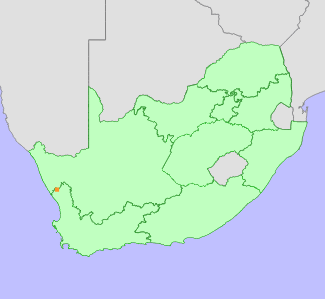|
Scientific Name | Conophytum bilobum (Marloth) N.E.Br. subsp. gracilistylum (L.Bolus) S.A.Hammer |
Higher Classification | Dicotyledons |
Family | AIZOACEAE |
Synonyms | Conophytum gracilistylum (L.Bolus) N.E.Br., Mesembryanthemum gracistylum L.Bolus |
National Status |
Status and Criteria | Critically Endangered A3d; B1ab(iii)+2ab(iii) |
Assessment Date | 2021/11/09 |
Assessor(s) | A.J. Young, P.G. Desmet, I. Ebrahim, D. Guo, A. Harrower, L. Jabar, L. Knoetze, C. Rodgerson, P.C.V. Van Wyk & N.N. Mhlongo |
Justification | This succulent is endemic to the Western Cape province of South Africa with an extent of occurrence (EOO) and area of occupancy (AOO) of 8 km². The dwarf succulents that comprise this genus have been increasingly targeted by illegal collection in recent years and the vast majority of species are in high demand by collectors. Whilst there is no evidence of illegal collection at the time of this submission, other subspecies within the same species, and other species of Conophytum from the immediate area, have been illegally removed from habitat with a dramatic increase in the number of species and volume of plants targeted since 2019. The threat of illegal collection is therefore regarded as very high for this particular subspecies given its single location and small population size a decline of up to 100% of the population is suspected to take place within the next 10 years. Anthropogenic climate change is another major threat to this species in the future. Loss of vegetation cover has been observed across the range occupied by this species via Landsat imagery between 1984 and 2018 and is used to infer that the habitat quality is already in decline. This taxon therefore qualifies as Critically Endangered under criteria A3 and B1+2. |
Distribution |
Endemism | South African endemic |
Provincial distribution | Western Cape |
Range | This taxon is endemic to a small part of the Western Cape of South Africa. |
Habitat and Ecology |
Major system | Terrestrial |
Major habitats | Southern Namaqualand Quartzite Klipkoppe Shrubland |
Description | This succulent is endemic to the Namaqualand Hardeveld bioregion of the Succulent Karoo biome. Plants occur on areas of broken gneiss, often seeking shelter within cracks or between rocks. This taxon has a generation length of 30 years. It is expected to be sensitive to the impacts of climate change as it does not disperse and while adapted to arid conditions, is dependent on limited seasonal rainfall. Species in the genus are sensitive to long periods of drought. Drought related mortality has been observed for other closely related taxa within the genus. |
Threats |
| This succulent is threatened by harvesting for the specialist succulent trade. The highly restricted geographic range (AOO of 8 km2) coupled with the small population size at the only known locality makes the subspecies very sensitive to such activity and rapid declines in mature individuals are possible and highly likely given the recent illegal harvesting to supply the new substantial demand from Asia for species within the genus.
There is an inferred decline in habitat quality at the only known locality for this taxon based on the loss of vegetation cover determined from changes in Enhanced Vegetation Index (EVI) between 1984 and 2018 using Landsat data (Venter et al. 2020).
Anthropogenic climate change is a long-term threat to this succulent. Climate models for the likely emission scenarios where emissions stay at present day levels (RCP 2.6) (Hausfather and Peters 2020) and worst case scenarios where emissions continue to increase during the 21st century (RCP 8.5) indicate that there will be a loss of suitable bioclimatic envelope of between 64% and 99% by 2080 for this species with the assumption that all subspecies will be similarly impacted. Species in this genus have limited dispersal ability and migration to suitable habitats elsewhere is regarded as highly unlikely. |
Population |
Plants are recorded from a single locality consisting of two subpopulations, each of which comprises no more than 500-1,000 mature individuals. The number of plants in this general area have been in decline in recent years due to an extended drought and the population may be in decline and is suspected to decline in future due to illegal collection for the succulent ornamental trade.
|
Population trend | Unknown |
Assessment History |
Taxon assessed |
Status and Criteria |
Citation/Red List version | | Conophytum bilobum (Marloth) N.E.Br. subsp. gracilistylum (L.Bolus) S.A.Hammer | Rare | 2017.1 | | Conophytum bilobum (Marloth) N.E.Br. subsp. gracilistylum (L.Bolus) S.A.Hammer | Least Concern | Raimondo et al. (2009) | |
Bibliography |
Hammer, S. 2002. Dumpling and his wife: New view of the genus Conophytum. EAE Creative Colour, Norwich.
Hammer, S.A. 1993. The genus Conophytum: A conograph. Succulent Plant Publications, Pretoria.
Hausfather, Z. and Peters, G.P. 2020. Emissions - the 'business as usual' story is misleading. Nature 577(618-620).
|
Citation |
| Young, A.J., Desmet, P.G., Ebrahim, I., Guo, D., Harrower, A., Jabar, L., Knoetze, L., Rodgerson, C., Van Wyk, P.C.V. & Mhlongo, N.N. 2021. Conophytum bilobum (Marloth) N.E.Br. subsp. gracilistylum (L.Bolus) S.A.Hammer. National Assessment: Red List of South African Plants version 2024.1. Accessed on 2025/11/07 |
 Comment on this assessment
Comment on this assessment


